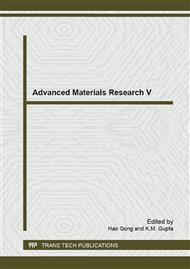p.110
p.117
p.123
p.127
p.131
p.136
p.141
p.149
p.154
Parametric Requirements for Optimum Performance of InGaP/GaAs Heterojonction Solar Cell
Abstract:
In this paper, we analyze the temperature effect on the performance of photovoltaic cells using a virtual wafer fabrication TCAD Silvaco. As is often done, the previous work on this solar cell involved optimizing it at 300 K, even though operating temperatures are typically higher. Therefore, for this article, we model the InGaP/GaAs heterojunction solar cell from 275 °K to 375° K in 25°K increments while varying their thicknesses and doping levels, as well as varying the molar fraction of InAlAsP, AlGaAs and InGaP. We chose to vary these design parameters to observe their effect on performance and suggest a better design for operating at higher temperatures.
Info:
Periodical:
Pages:
131-135
Citation:
Online since:
May 2015
Authors:
Keywords:
Price:
Сopyright:
© 2015 Trans Tech Publications Ltd. All Rights Reserved
Share:
Citation:


